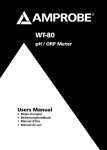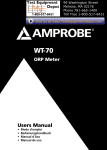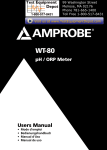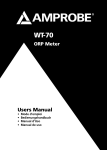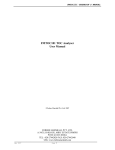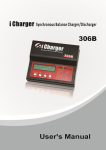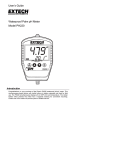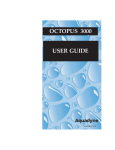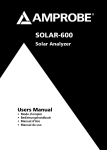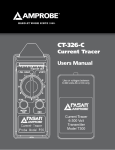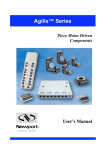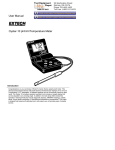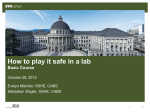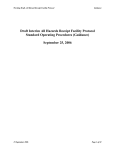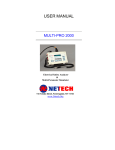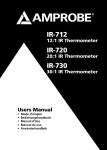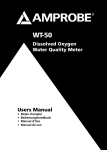Download Users Manual
Transcript
WT-40 Dual Display pH, mV & Temp. Meter Users Manual • • • • Mode d’emploi Bedienungshandbuch Manual d’Uso Manual de uso WT-40 Users Manual September 2009, Rev.1 ©2009 Amprobe Test Tools. All rights reserved. Printed in China English Dual Display pH, mV & Temp. Meter Limitation of Liability Your Amprobe product will be free from defects in material and workmanship for 1 year from the date of purchase. This warranty does not cover fuses, disposable batteries or damage from accident, neglect, misuse, alteration, contamination, or abnormal conditions of operation or handling. Resellers are not authorized to extend any other warranty on Amprobe’s behalf. To obtain service during the warranty period, return the product with proof of purchase to an authorized Amprobe Test Tools Service Center or to an Amprobe dealer or distributor. See Repair Section for details. THIS WARRANTY IS YOUR ONLY REMEDY. ALL OTHER WARRANTIES WHETHER EXPRESS, IMPLIED OR STAUTORY - INCLUDING IMPLIED WARRANTIES OF FITNESS FOR A PARTICULAR PURPOSE OR MERCHANTABILITY, ARE HEREBY DISCLAIMED. MANUFACTURER SHALL NOT BE LIABLE FOR ANY SPECIAL, INDIRECT, INCIDENTAL OR CONSEQUENTIAL DAMAGES OR LOSSES, ARISING FROM ANY CAUSE OR THEORY. Since some states or countries do not allow the exclusion or limitation of an implied warranty or of incidental or consequential damages, this limitation of liability may not apply to you. Repair All test tools returned for warranty or non-warranty repair or for calibration should be accompanied by the following: your name, company’s name, address, telephone number, and proof of purchase. Additionally, please include a brief description of the problem or the service requested and include the test leads with the meter. Non-warranty repair or replacement charges should be remitted in the form of a check, a money order, credit card with expiration date, or a purchase order made payable to Amprobe® Test Tools. In-Warranty Repairs and Replacement – All Countries Please read the warranty statement and check your battery before requesting repair. During the warranty period any defective test tool can be returned to your Amprobe® Test Tools distributor for an exchange for the same or like product. Please check the “Where to Buy” section on www.amprobe.com for a list of distributors near you. Additionally, in the United States and Canada In-Warranty repair and replacement units can also be sent to a Amprobe® Test Tools Service Center (see below for address). Non-Warranty Repairs and Replacement – US and Canada Non-warranty repairs in the United States and Canada should be sent to a Amprobe® Test Tools Service Center. Call Amprobe® Test Tools or inquire at your point of purchase for current repair and replacement rates. In USA Amprobe Test Tools Everett, WA 98203 Tel: 888-993-5853 Fax: 425-446-6390 In Canada Amprobe Test Tools Mississauga, ON L4Z 1X9 Tel: 905-890-7600 Fax: 905-890-6866 Non-Warranty Repairs and Replacement – Europe European non-warranty units can be replaced by your Amprobe® Test Tools distributor for a nominal charge. Please check the “Where to Buy” section on www.amprobe.com for a list of distributors near you. Amprobe® Test Tools Europe In den Engematten 14 79286 Glottertal, Germany tel: +49 (0) 7684 8009 - 0 *(Correspondence only – no repair or replacement available from this address. European customers please contact your distributor.) WT-40 Dual Display ph, mV & Temp. Meter 1 9 2 7 6 8 4 3 5 Meter 1 Probe socket 2 LCD display 3 Operation keys 5 USB port 4 Adaptor port 6 Battery cover (rear side) 7 Tripod mount hole (rear side) 8 pH propbe with soak bottle 9 pH probe temperature plug LCD 1 pH reading in unit pH or mV 2 Low battery indicator 3 READY to indicate the reading is stable 4 Review maximum and minimum record 5 Freeze display 6 Meter is in recall mode 7 Total numbers of records 8 Real time clock 9 The meter is in auto temp. compensation status 10 Temperature unit. oC or oF is selectable 11 Meter is in calibration mode POWR/SET KEY: Press key to turn on and off the meter. When the meter is on, hold down for >1 second to enter setting mode. CAL/ESC KEY: Press to switch normal and calibration mode. While in calibration, setting or recall mode, press to return to previous mode. HOLD/REC KEY: Press key to freeze current reading. Press again to unlock. Press >1 second to switch normal and recall mode. When the meter is off, press SET+HOLD simultaneously >1 second to disable auto-sleep mode MODE/UP KEY: Press this key to switch pH and mV. In setting or calibration mode, press to increase value. MEMORY/DOWN KEY: Press to record current reading. In setting or calibration mode, press to decrease the value MAX/MIN/ENTER KEY: Press to view the max./ min. of the memory in recall mode. In setting or calibration mode, press to confirm and enter next step. WT-40 Dual Display ph, mV & Temp. Meter CONTENTS SYMBOLS................................................................................................................1 UNPACKING AND INSPECTION .............................................................................1 INTRODUCTION......................................................................................................2 Features .............................................................................................................2 OPERATION.............................................................................................................2 Starting Up.........................................................................................................2 pH/mV Measurement.........................................................................................2 Manual Temperature Compensation (MTC) ....................................................3 HOLD Function...................................................................................................3 Memory Record..................................................................................................3 Memory Recall....................................................................................................3 Backlight . ..........................................................................................................4 Auto Power Off..................................................................................................4 Setup . ................................................................................................................4 Calibration..........................................................................................................7 SPECIFICATIONS ....................................................................................................8 MAINTENANCE AND REPAIR.................................................................................8 Battery Replacement ........................................................................................9 USB PC Interface Capabilities ...........................................................................9 TROUBLE SHOOTING..............................................................................................9 MSDS.......................................................................................................................11 SYMBOLS � Caution ! Refer to the explanation in this Manual � � Complies with European Directives = Complies with European Directives Do not dispose of this meter as unsorted municipal waste. Contact a qualified recycler for disposal. � WARNINGS AND PRECAUTIONS Please always keep the electrode glass bulb wet by using the soak bottle to protect and store the electrode. Always rinse the pH electrode and reference junction in de-ionized water before next use. Never touch or rub glass bulb to lengthen the electrode life. Recommend soak the electrode for at least 30 minutes before using, especially if the electrode dries out between uses or after long time unuses. UNPACKING AND INSPECTION 1 WT-40 meter 1 pH Probe with soak bottle 3 pH standard solution (4, 7, 10, non-NIST) 4 AAA battery 1 Manual 1 INTRODUCTION Congratulations on your purchase of WT-40 water quality meter. A convenient instrument to measure water pH, mV and temperature value. FEATURES • • • • • • • • Automatic buffer recognition to avoid pH calibration error. Hold function to freeze the record. Max./Min. review of memorized data. Backlight for dark environment operation. Easy to view pH probe calibration data. USB connection for data download to a PC pH electrode with automatic temperature compensation. Auto power off to save battery power OPERATION Starting Up 1. Install batteries or connect with an adaptor to the power socket. 2.Connect pH electrode to the BNC port on the top of the meter. To activate ATC, please also connect the temperature sensor plug to the socket next to BNC. 3. Available parameters for pH probe are pH value, mV value & Temperature. pH/mV Measurement WT-40 is designed to take reading with automatic or manual temperature compensation. Automatic temperature compensation only occurs when the temp.sensor is plugged. For manual temperature compensation, the default setting is 25 oC. You can manually adjust the temperature. Be sure to remove the pH electrode soaker bottle before measurement. To take the readings: 1. Rinse the probe with de-ionized or distilled water before use to remove any impurities adhering to the probe. If the electrode is dehydrated, soak it for 30 minutes in KCl solution. 2. Press “POWER” key to power on. “ATC” icon appears to indicate automatic temp. compensation while the temp. probe is plugged. 2 3. Dip the electrode into the sample, the electrode must be completely immersed into the sample. Stir the probe gently to create a homogenous sample. 4. Wait until the “READY“ icon appears. (Fig. 1) 5. To toggle between pH and mV, press “MODE” key.(Fig.2) Manual Temperature Compensation (MTC) Simply disconnect the Temp. sensor from meter and select the mode as pH. To set the temperature, press “ENTER” KEY more than 1 second until ”CR“ flashes on LCD. Press “ “or “ ” key to change the temperature value and press “ENTER” key to save and return to normal measurement mode. HOLD Function o freeze the current readings while in normal measurement mode. To hold T the readings, press “HOLD” key in measurement mode, " HLD “appears on the display. To release the holding value, press “HOLD” key again. (Fig.3) Memory Record The meter can store each parameter for up to 99 records. To record: 1. In any measurement or HOLD mode, press “MEM” key to save data. 2. Memory number & measured value will flash then return to measurement mode. (Fig. 4). New data can not be saved if the memory is full. To continuously save new memory, it is needed to clear up existing 99 memories. Memory Recall Recall function can review previous saved record. To recall record: 1. Press “REC” key > 2 seconds to enter recall mode. "REC“ icon will flash on the LCD. 2. Press “ ” or “ ” key review memory one by one. 3. Press “MI/MX/AV” key to view the minimum & maximum value of the memory. (Fig. 5) 4. To exit memory recall, press “REC” key > 2 sec. to return to measurement mode. All records are retained even the meter is powered off. 3 Backlight ress any key to activate the backlight function. The backlight turns off P automatically after 10 seconds of inactivity. Auto Power Off This meter will shut off automatically 20 minutes of inactivity. To disable the auto power off, pressing " SET “ + “ HOLD” keys simultaneously while turning on the meter until a "n” appeared on the screen and then release keys to return to normal mode. Setup The advanced setup mode lets you customize your meter. 7 parameters are available in this model. P2.0: Clear memory P3.0: Electrode data P4.0: PH buffer selection P5.0: READY indication P6.0: Temperature unit P7.0: Real time clock P8.0: Reset To enter SETUP mode, hold down “SET”key >1 second while in normal measurement mode. Press “ ” or “ ”to select parameters and press “ENTER”for parameter settings. To exit any setting, press “Esc” key. Note: P1.0 memory transmitting function is not available in this model. P2.0 Memory Clear(CLr) o clear the stored data, press “MODE” key to select the parameter (pH or T mV) which you want to clear before entering setup mode. 4 While in setup mode, press “ ” key to select memory clear function P2.0, “CLr” icon appears on LCD (Fig.6) Press “ENTER” key to enter P2.1.The default “ NO" icon flashes on LCD. Press “ ” key to change and then press “ENTER” key to confirm. NOTE: This procedure will clear 99 memories at a time. Please consider carefully before delete. P3.0 Electrode (ELE) To view the pH electrode data (slope & offset value) from WT-40: Press “MODE” key to select the mode as pH before entering setting mode. Press “ ” to select P3.0 while in setting mode, “ELE “ appears on the LCD. Press “ENTER” key to enter P3.1, LCD displays 1of 4 available slope values (P3.1 to P3.4). If the value is <75% or >115%, suggest to change electrode immediately. Press “ENTER” key to review P3.2, P3.3 & P3.4 (Fig. 7) ress “ENTER” to enter P3.5 to view the offset value.(Fig. 8) Offset value is the P mV value of pH 7 and the default offset value is 0.0. The offset value will be different after re-calibration. When the offset value is out of range +60mV, strongly suggest you to replace with a new probe. NOTE: P3.1, 3.2, P3.3 & P3.4 slope definition of buffer: P3.1 P3.2 P3.3 P3.4 NIST 0.00~4.01 4.01~6.86 6.86~9.18 9.18~14.00 NON-NIST 0.00~4.50 4.50~7.00 7.00~9.50 9.50~14.00 P4.0 pH Buffer (buF) Before pH calibration, select the buffer you use. You can use NIST buffer or non-NIST (here refer as “Custom” buffer) for calibration purpose. Correct buffer selection can help meter to recognize the buffer and calibrate the probe more precisely. 5 NIST buffer: PH1.68, 4.01, 6.86, 9.18, 12.45. Custom buffer: 5 ranges, PH 1.00~3.00, 3.50~5.50,6.00~8.00, 8.50~10.50,11.50~13.50. Press “ ” key to select pH buffer program P4.0 while in setting mode. “buF” icon appears on LCD. Press “ENTER” key to enter P4.1.The default " NIST “ icon flashes on the LCD. Press “ENTER” key to confirm or press “MODE” key to change. (Fig.9) The pH buffer enclosed in the standard package is non-NIST. P5.0 READY indication (rdy) Use this program to activate “READY” indication. “READY” icon appears on LCD when the measured reading is stable. While in P5.0, press “ENTER”to go into P5.1 and press “ ” or “ ” to switch Ready indicator ON or OFF and then press “ENTER” to confirm. (Fig. 10) P6.0 Temperature Unit (U) Use this program to select the temperature unit. While in P6.0, press “ENTER”to go into P6.1 and press “ ” or “ ” to switch C or F and then press “ENTER” to confirm. (Fig. 11) P7.0: Real Time Clock (rtc) In P7.0, press “ENTER” to go through P7.1 to P7.6 for date and time settings. Y-M-D and H:M:S will show in turn and corresponding digits will be flashing for further change. Press “ ” to increase and “ ” to decrease the numbers and press “ENTER”key to confirm every setting. P8.0: Reset (rSt) While in P8.0, press “ENTER”to go into P8.1. Select "n"-No or "y"-Yes with “ ”or “ ” for data reset to factory default. Press “ENTER”to confirm selection. 6 Calibration We recommend to operate at least a 2-point calibration. If you can only perform a 1-point calibration, please make sure the buffer value is very closed to the sample you are measuring and the buffer temperature must be stable enough. 1. Select “pH” mode. Rinse the pH electrode in de-ionized water or rinse solution. DON'T wipe the pH probe dry. Wiping the probe may cause static and cause calibration and measurement instability. 2. Select the pH buffer (See P4.0) and pour some into a clean container. Dip the probe into the buffer. The end of the probe must be immersed into the buffer. Stir the probe gently to create a homogenous sample. 3. Press “CAL” key to enter calibration mode. The “CA” icon flashes on LCD. 4. If the buffer is set as NIST in P4.0, the main display shows the auto recognized buffer value. (Fig. 12). If this value keeps changing means the buffer or probe need to be checked or changed. 5. If the buffer is set as CUST in P4.0, the main display shows default 2.00, short press “HLD” key to select the buffer range you are using. Then, press “ ” or “ ” key to fine adjust the value in order to meet with buffer. 6. Wait until “Ready” icon appear on LCD. Press “ENTER” to confirm. 7. Change buffer & repeat step 5~6 to do multiple points calibration or press “ENTER” key to end the calibration and return to normal mode. NOTE: When in calibration, the buffer temperature must be stable enough. 7 SPECIFICATIONS pH range: 0.00~14.00pH pH resolution: 0.01pH pH accuracy: +0.02pH mV range: -1999mV~+1999mV mV resolution: 0.1mV(-199.9mV~+199.9mV), 1mV at others mV accuracy: +0.2mV(-199.9mV~+199.9mV), +2mV at others ATC: -5~80°C / 23~176°F Temperature Accuracy: ±0.3°C Operation temp.: 0~50°C / 50~122°F Operation RH%: 0~80%RH Power Requirements: 4pcs AAA � - EMC: Conforms to EN61326-1. This product complies with requirements of the following European Community Directives: 89/ 336/ EEC (Electromagnetic Compatibility) and 73/ 23/ EEC (Low Voltage) as amended by 93/ 68/ EEC (CE Marking). However, electrical noise or intense electromagnetic fields in the vicinity of the equipment may disturb the measurement circuit. Measuring instruments will also respond to unwanted signals that may be present within the measurement circuit. Users should exercise care and take appropriate precautions to avoid misleading results when making measurements in the presence of electronic interference. MAINTENANCE AND REPAIR If there appears to be a malfunction during the operation of the meter, the following steps should be performed in order to isolate the cause of the problem. 1. Check the battery. Replace the battery immediately when the symbol “ ” appears on the LCD. 2. Review the operating instructions for possible mistakes in operating procedure. Except for the replacement of the battery, repair of the meter should be performed only by a Factory Authorized Service Center or by other qualified instrument service personnel. The front panel and case can be cleaned with a mild solution of detergent and water. Apply sparingly with a soft cloth and allow to dry completely before using. Do not use aromatic hydrocarbons, Gasoline or chlorinated solvents for cleaning. 8 Always keep pH probe wet when in storage. The probe is well protected by a plastic bottle with soak solution in it. To use the probes, rotate the bottle and remove the bottle away from the probe. pH probe can be stored in a 3M KCL solution. Never use distilled water for storage. Always rinse the pH electrode in de-ionized water before next use. Never touch or rub glass bulb for lasting pH electrode life. Battery Replacement 1. Turn off the meter and open the battery cover. 2. Replace the old batteries with four new AAA batteries. USB PC Interface Capabilities The USB cable and software are required to transfer data to a pc. The USB port is located on the right side of the instrument. The USB cable is not included. it can be purchased separately as an optional accessory. The protocol is: Format: pxx.xxpH:mxx.xxmV:Txxx.xC(F) @2007-04-18 18:48:48LRCCRLF Baud rate: 9600 bit/sec Data bit: 8 Stop bit: 1 Parity: none TROUBLESHOOTING • • • • ower on but no display P Make sure you press power key >0.3second. Check the battery conditions and replace if necessary Move batteries away for one minute and then re-install. Display disappear Check whether the low battery icon is appeared before the display is off. If yes, replace with new batteries. Unstable reading • S tir the solution to make homogeneous status and make sure the sensor is completely immersed in solution. 9 • Make sure the measurement is processed in container. • Clean or re-calibrate or replace with a new probe • Move to another room and try again , it is supposed that the unstable reading is caused by strong RF interference field. The reading is not changed • If the status is in "HOLD", release the status. • If the measurement is in MTC, input temperature value. Slow response • Clean and re-calibrate the probe. • Replace with a new probe. Wrong real time • The wrong real time display will not affect the measurement. Contact the distributor to purchase battery and acquire replacement procedures. Error code E02 Reading is under the lower limit E03 Reading is over the upper limit E04 The original data error result in this error E12 Factory calibration data error Solution: Re-start meter might solve this error E13 Slope or offset value of pH probe is out of the range E31 Measuring circuit failure Solution: Re-start meter might solve this error E32 Memory IC failure 10 MATERIAL SAFETY DATA SHEET OF SOAK SOLUTION SECTION I - IDENTITY INFORMATION INGREDIENT: KCL CHEMICAL NAME: Potassium monochloride CAS No.:7447-40-7 MANUFACTURER: Ajax Finechem (http://www.ajaxfinechem.com/) PHONE: +61 1300 884 078 DATE PREPARED: 2006-04-24 SECTION II -PHYSICAL/CHEMICAL CHARACTERISTIC BOILING POINT: Not available MELTING POINT: 773 degree C / 1423°F VAPOR PRESSURE: Not available. WATER SOLUBILITY: Soluble APPEARANCE /ODOR: Colourless or white crystals, odorless SECTION III - HEALTH HAZARD DATA ROUTE OF ENTRY: Inhalation, Ingestion, skin & eye absorption HEALTH HAZARDS: Inhalation may cause respiratory tract irritation. Irritative to eyes and skin. Harmful if swallowed. SECTION IV: EMERGENCY & FIRST AID MEASURES EYES: Immediately flush eyes with plenty of water for at least 15 minutes, occasionally lift the upper and lower eyelids. Get medical aid. SKIN: Remove contaminated clothing and shoes. Flush skin with plenty of water for at least 15 minutes. Get medical aid. INHALATION: Remove from exposure to fresh air immediately. If not breathing, give artificial respiration. If breathing is difficult, give oxygen. Get medical aid. INGESTION: Do not induce vomiting. Get medical aid if irritation or symptoms occur. 11 SECTION V: FIRE FIGHTING MEASURES FLASH POINT : not flammable SPECIAL FIRE FIGHTING PROCEDURES: Wear self-contained breathing apparatus and protective clothing to prevent contact with skin and clothing. UNUSUAL FIRE & EXPLOSION HAZARDS: Not combustible SECTION VI - EXPOSURE CONTROLS, PERSONAL PROTECTION Wear appropriate protective eyeglasses or chemical safety goggles. Wear appropriate protective gloves to prevent skin exposure. Wear appropriate protective clothing to minimize contact with skin. Use NIOSH/MSHA or European standard EN149 approved respirator if exposure limits are exceeded or if irritation or other symptoms are experienced. SECTION VII - HANDLING AND STORAGE HANDLING: Avoid generating dust. Use smallest possible amounts in designated areas with adequate ventilation. Have emergency equipment (for fires, spills, leaks, etc.) readily available. Label containers. Keep containers closed when not in use. Wear appropriate protective equipment to prevent inhalation, skin and eye contact. Ensure a high level of personal hygiene is maintained when using this product. That is; always wash hands before eating, drinking, smoking or using the toilet. STORAGE: Store in a cool, dry, well-ventilated area, out of direct sunlight and moisture. Store in labelled containers. Keep containers tightly closed. Store away from bases, water and other incompatible materials. Have appropriate fire extinguishers available in and near the storage area. SECTION VIII - REACTIVITY DATA STABILITY: Stable under normal temperature and pressures. HAZARDOUS POLYMERIZATION: Will not occur MATERIALS TO AVOID: None known 12 DISCLAIMER The above information is transferred to this format by Amprobe from the Material Safety Data Sheet supplied by the manufacturer identified in Section I. If you have any questions related to the material provided herein, contact the manufacturer directly at the phone number given in Section I. Amprobe does not, in any way, represent itself as an expert in the chemical described in this MSDS and assume in liability for any incomplete or inaccurate information contained herein." MATERIAL SAFETY DATA SHEET OF pH4 BUFFER SECTION I - IDENTITY INFORMATION INGREDIENT: Potassium hydrogen phthalate (C8H5O4K) CHEMICAL NAME: Potassium hydrogen phthalate CAS No.: 877-24-7 MANUFACTURER: Ajax Finechem (http://www.ajaxfinechem.com/) PHONE: +61 1300 884 078 DATE PREPARED: 2005-10-14 SECTION II -PHYSICAL/CHEMICAL CHARACTERISTICS BOILING POINT: Not available MELTING POINT: 295-300 degree C / 563-572 °F VAPOR PRESSURE: Not available. WATER SOLUBILITY: Soluble APPEARANCE /ODOR: white crystalline powder, odorless SECTION III - HEALTH HAZARD DATA ROUTE OF ENTRY: Inhalation, Ingestion, skin & eye absorption HEALTH HAZARDS: Inhalation may cause respiratory tract irritation. Irritative to eyes and skin. Harmful if swallowed. 13 SECTION IV: EMERGENCY & FIRST AID MEASURES EYES: "Immediately flush eyes with plenty of water for at least 15 minutes, occasionally lift the upper and lower eyelids. Get medical aid. SKIN: Remove contaminated clothing and shoes. Flush skin with plenty of water for at least 15 minutes. Get medical aid. INHALATION: Remove from exposure to fresh air immediately. If not breathing, give artificial respiration. If breathing is difficult, give oxygen. Get medical aid. INGESTION: Do not induce vomiting. Get medical aid if irritation or symptoms occur. SECTION V: FIRE FIGHTING MEASURES FLASH POINT: not flammable SPECIAL FIRE FIGHTING PROCEDURES: Wear self-contained breathing apparatus and protective clothing to prevent contact with skin and clothing. UNUSUAL FIRE & EXPLOSION HAZARDS: Not combustible SECTION VI - EXPOSURE CONTROLS, PERSONAL PROTECTION Wear appropriate protective eyeglasses or chemical safety goggles. Wear appropriate protective gloves to prevent skin exposure. Wear appropriate protective clothing to minimize contact with skin. Use NIOSH/MSHA or European standard EN149 approved respirator if exposure limits are exceeded or if irritation or other symptoms are experienced. SECTION VII - HANDLING AND STORAGE HANDLING: Avoid generating dust. Use smallest possible amounts in designated areas with adequate ventilation. Have emergency equipment (for fires, spills, leaks, etc.) readily available. Label containers. Keep containers closed when not in use. Wear appropriate protective equipment to prevent inhalation, skin and eye contact. Ensure a high level of personal hygiene is maintained when using this product. That is; always wash hands before eating, drinking, smoking or using the toilet. STORAGE: Store in a cool, dry, well-ventilated area, out of direct sunlight and moisture. Store in labelled containers. Keep containers tightly closed. Store away from bases, water and other incompatible materials. Have appropriate fire extinguishers available in and near the storage area. 14 SECTION VIII - REACTIVITY DATA STABILITY: Stable under normal temperature and pressures. HAZARDOUS POLYMERIZATION: Will not occur MATERIALS TO AVOID: Strong oxidizing agents, nitric acid. DISCLAIMER The above information is transferred to this format by Amprobe from the Material Safety Data Sheet supplied by the manufacturer identified in Section I. If you have any questions related to the material provided herein, contact the manufacturer directly at the phone number given in Section I. Amprobe does not, in any way, represent itself as an expert in the chemical described in this MSDS and assume in liability for any incomplete or inaccurate information contained herein. MATERIAL SAFETY DATA SHEET OF pH7 BUFFER SECTION I - IDENTITY INFORMATION INGREDIENT: Na2HPO4&KH2PO4 CHEMICAL NAME: Anhydrous disodium phosphate & Potassium dihydrogen orthophosphate CAS No.: 7558-79-4 & 7778-77-0 MANUFACTURER: Ajax Finechem (http://www.ajaxfinechem.com/) PHONE: +61 1300 884 078 DATE PREPARED: 2008-01-12 SECTION II -PHYSICAL/CHEMICAL CHARACTERISTICS BOILING POINT: Not available MELTING POINT: Not available& 252.6 degree C / 486.7 °F VAPOR PRESSURE: Not available. WATER SOLUBILITY: Soluble APPEARANCE /ODOR: white crystalline powder, odorless 15 SECTION III - HEALTH HAZARD DATA ROUTE OF ENTRY: Inhalation, Ingestion, skin & eye absorption HEALTH HAZARDS: Inhalation may cause respiratory tract irritation. Irritative to eyes and skin. Harmful if swallowed. SECTION IV: EMERGENCY & FIRST AID MEASURES EYES: Immediately flush eyes with plenty of water for at least 15 minutes, occasionally lift the upper and lower eyelids. Get medical aid. SKIN: Remove contaminated clothing and shoes. Flush skin with plenty of water for at least 15 minutes. Get medical aid. INHALATION: Remove from exposure to fresh air immediately. If not breathing, give artificial respiration. If breathing is difficult, give oxygen. Get medical aid. INGESTION: Do not induce vomiting. Get medical aid if irritation or symptoms occur. SECTION V: FIRE FIGHTING MEASURES FLASH POINT: not flammable SPECIAL FIRE FIGHTING PROCEDURES: Wear self-contained breathing apparatus and protective clothing to prevent contact with skin and clothing. UNUSUAL FIRE & EXPLOSION HAZARDS: Not combustible SECTION VI - EXPOSURE CONTROLS, PERSONAL PROTECTION Wear appropriate protective eyeglasses or chemical safety goggles. Wear appropriate protective gloves to prevent skin exposure. Wear appropriate protective clothing to minimize contact with skin. Use NIOSH/MSHA or European standard EN149 approved respirator if exposure limits are exceeded or if irritation or other symptoms are experienced. SECTION VII - HANDLING AND STORAGE HANDLING: Avoid generating dust. Use smallest possible amounts in designated areas with adequate ventilation. Have emergency equipment (for fires, spills, leaks, etc.) readily available. Label containers. Keep containers closed when not in use. Wear appropriate protective equipment to prevent inhalation, skin and eye contact. Ensure a high level of personal hygiene is maintained when using this product. That is; always wash hands before eating, drinking, smoking or using the toilet. 16 STORAGE: Store in a cool, dry, well-ventilated area, out of direct sunlight and moisture. Store in labelled containers. Keep containers tightly closed. Store away from bases, water and other incompatible materials. Have appropriate fire extinguishers available in and near the storage area. SECTION VIII - REACTIVITY DATA STABILITY: Stable under normal temperature and pressures. HAZARDOUS POLYMERIZATION: Will not occur MATERIALS TO AVOID: Strong oxidising agents and strong acids DISCLAIMER The above information is transferred to this format by Amprobe from the Material Safety Data Sheet supplied by the manufacturer identified in Section I. If you have any questions related to the material provided herein, contact the manufacturer directly at the phone number given in Section I. Amprobe does not, in any way, represent itself as an expert in the chemical described in this MSDS and assume in liability for any incomplete or inaccurate information contained herein. MATERIAL SAFETY DATA SHEET OF pH10 BUFFER SECTION I - IDENTITY INFORMATION INGREDIENT: Na2CO3 & NaHCO3 CHEMICAL NAME: Disodium carbonate & Sodium acid carbonate CAS No.: 497-19-8 & 144-55-8 MANUFACTURER: Ajax Finechem (http://www.ajaxfinechem.com/) PHONE: +61 1300 884 078 DATE PREPARED: 2006-07-21 SECTION II - PHYSICAL/CHEMICAL CHARACTERISTICS BOILING POINT: Not available MELTING POINT: 851°C & Not available VAPOR PRESSURE: Not available. WATER SOLUBILITY: Soluble APPEARANCE /ODOR: white crystalline powder, odorless 17 SECTION III - HEALTH HAZARD DATA ROUTE OF ENTRY: Inhalation, Ingestion, skin & eye absorption HEALTH HAZARDS: Inhalation may cause respiratory tract irritation. Irritative to eyes and skin. Harmful if swallowed. SECTION IV: EMERGENCY & FIRST AID MEASURES EYES: Immediately flush eyes with plenty of water for at least 15 minutes, occasionally lift the upper and lower eyelids. Get medical aid. SKIN: Remove contaminated clothing and shoes. Flush skin with plenty of water for at least 15 minutes. Get medical aid. INHALATION: Remove from exposure to fresh air immediately. If not breathing, give artificial respiration. If breathing is difficult, give oxygen. Get medical aid. INGESTION: Do not induce vomiting. Get medical aid if irritation or symptoms occur. SECTION V: FIRE FIGHTING MEASURES FLASH POINT: not flammable SPECIAL FIRE FIGHTING PROCEDURES: Wear self-contained breathing apparatus and protective clothing to prevent contact with skin and clothing. UNUSUAL FIRE & EXPLOSION HAZARDS: Not combustible SECTION VI - EXPOSURE CONTROLS, PERSONAL PROTECTION Wear appropriate protective eyeglasses or chemical safety goggles. Wear appropriate protective gloves to prevent skin exposure. Wear appropriate protective clothing to minimize contact with skin. Use NIOSH/MSHA or European standard EN149 approved respirator if exposure limits are exceeded or if irritation or other symptoms are experienced. 18 SECTION VII - HANDLING AND STORAGE HANDLING: Avoid generating dust. Use smallest possible amounts in designated areas with adequate ventilation. Have emergency equipment (for fires, spills, leaks, etc.) readily available. Label containers. Keep containers closed when not in use. Wear appropriate protective equipment to prevent inhalation, skin and eye contact. Ensure a high level of personal hygiene is maintained when using this product. That is; always wash hands before eating, drinking, smoking or using the toilet. STORAGE: Store in a cool, dry, well-ventilated area, out of direct sunlight and moisture. Store in labelled containers. Keep containers tightly closed. Store away from bases, water and other incompatible materials. Have appropriate fire extinguishers available in and near the storage area. SECTION VIII - REACTIVITY DATA STABILITY: Stable under normal temperature and pressures. HAZARDOUS POLYMERIZATION: Will not occur MATERIALS TO AVOID: Reacts violently with acids to form carbon dioxide. DISCLAIMER The above information is transferred to this format by Amprobe from the Material Safety Data Sheet supplied by the manufacturer identified in Section I. If you have any questions related to the material provided herein, contact the manufacturer directly at the phone number given in Section I. Amprobe does not, in any way, represent itself as an expert in the chemical described in this MSDS and assume in liability for any incomplete or inaccurate information contained herein. 19 Fig.1 Fig.2 Fig. Fig.4 Fig.5 Fig.6 Fig.7 Fig.8 Fig.9 Fig.10 Fig.11 Fig.12 20 21



























